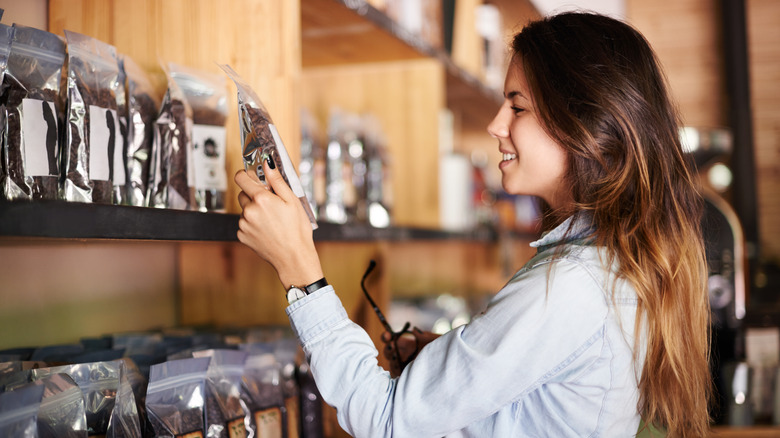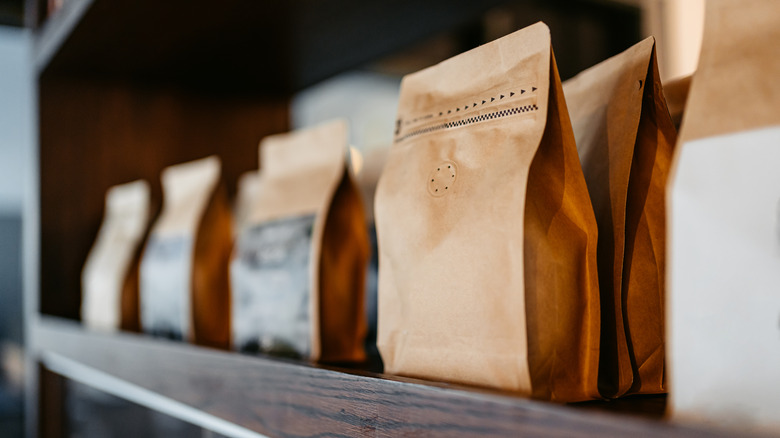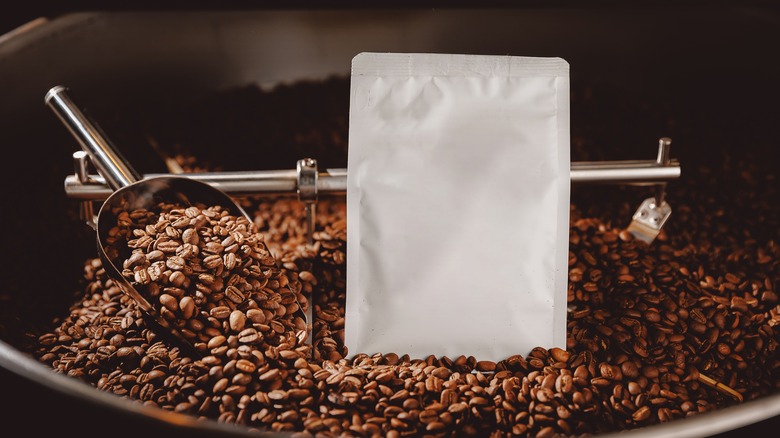The Green Flag To Search For When Buying Coffee Beans
One of the best points we'd say belongs in the beginner's guide to coffee beans is the importance of how coffee beans are packaged. For the freshest coffee possible, a fully-sealed bag of beans with a one-way valve is the green flag you should be searching for on the shelves. This packaging style is the optimal choice for coffee beans as it keeps those vulnerable legumes safe from excess moisture and air while preserving the environment inside the bag.
Compared to other packaging methods, such as vacuum-sealed bags, a fully-sealed bag of beans with a valve is the better choice for that reason. This method offers higher levels of freshness and extended preservation, so you can make as many cups of coffee from one bag as possible without having to dump any over time for diminished quality. This is because fresh coffee beans naturally release carbon dioxide gas, and that air needs a way to escape the bag. That's where the one-way valve comes in. These valves allow CO2 to be released without letting in any excess oxygen. Oxygen is a freshness killer for coffee beans, leaving them with a stale, rusty flavor. So if you don't see a one-valve, (often small little holes are visible on the front of the packaging) run, because it might mean that there are old or unsavory beans inside.
The coffee bean packaging you should avoid
We've touched on what type of packaging you should search for, so let's talk about the ones you should avoid. For starters, stay away from bags without a one-way valve. You might notice coffee beans that are in packages without this handy gadget might be packed full of excess air as the beans cannot release their natural gasses. This is not only bad for the freshness of the beans, but it's also dangerous as the bag could burst open after an extended period of time. Additionally, you might think vacuum-sealed bags better preserve the freshness of coffee beans, but these also prevent the coffee from releasing that gas.
Next, you should also avoid paper bags or bags without a seal. Paper or bags you have to fold over are much more vulnerable to letting in excess oxygen. Oxygen leads to stale beans as the air whittles away at their robust flavor and aroma, so it's something you want to avoid.
So, for the best quality and convenience, opt for a fully sealable bag with a one-way valve. These bags will keep beans fresh much longer so you don't have to sacrifice any stale coffee. Plus, since the packaging is ideal, you can feel pretty confident that you're buying good beans, too. Bonus: If you press down on these bags, the gas inside will be released through the valve, and you can smell the coffee's quality for yourself.
The uncertain future of one-way valves
While one-way valve bags are ideal, they might eventually become a thing of the past, and this is a change coffee lovers should remain aware of. Recently, some roasters need to make a choice because recyclable bags are on the rise and no viable replacement for the plastic one-way valves has been made to accompany them. This means some roasters have forgone the valve for recyclability purposes, creating valve-adjacent inventions for their coffee bags instead. For some, this invention is as simple as a small slit at the top of the bag to allow the carbon dioxide to escape. While this isn't as ideal as a traditional one-way valve, it does prevent the bags from exploding and is much better than no hole at all. Plus, the carbon dioxide will still escape faster than oxygen can get in, so this method still has some pros and is a good compromise for the environmentally conscious.
In conclusion, it's best to do your research to discover which type of coffee beans will best suit your needs, but generally, beans kept in a sealable bag with a one-way valve work best. (And if you want them to stick around a while longer, you can even freeze your coffee beans to keep them extra fresh.


